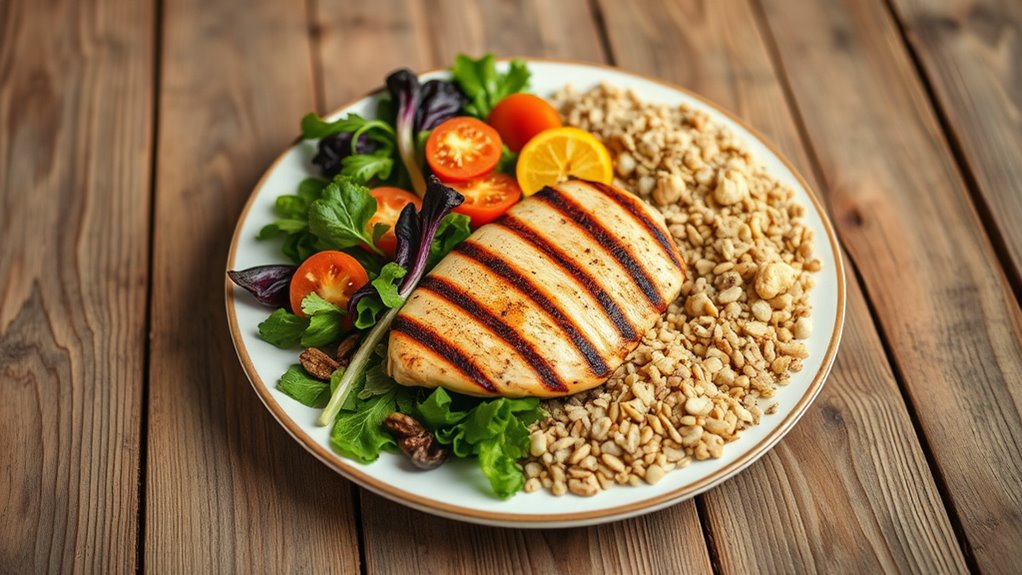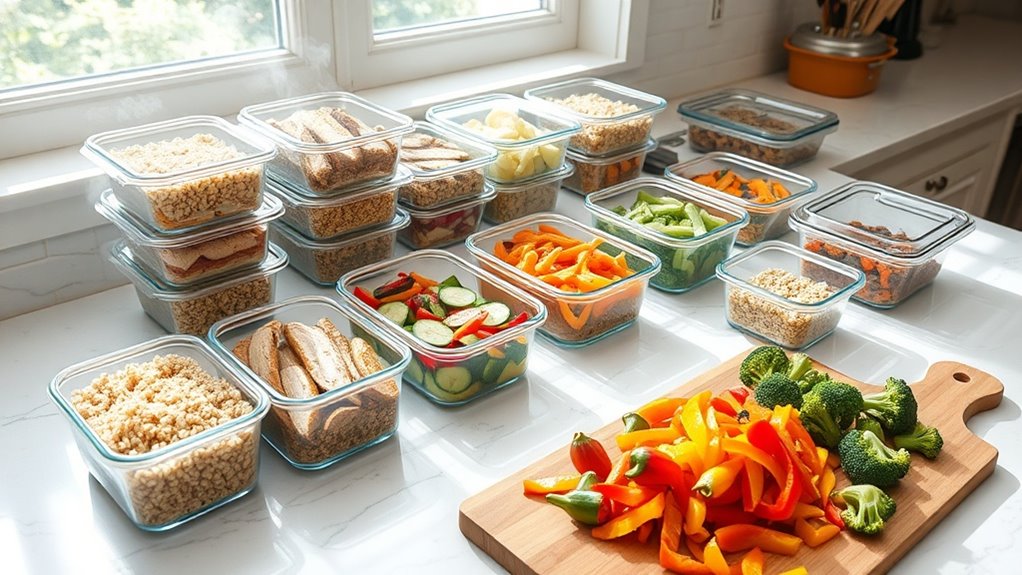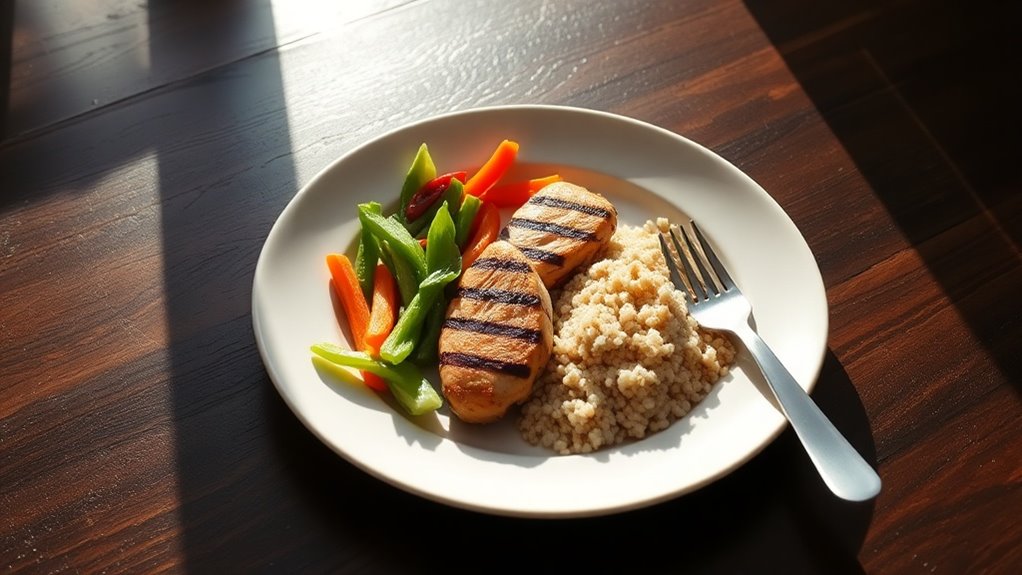The Secret Formula for Building a Fat-Burning Plate
You’ve probably heard that 70% of weight loss success stems from balanced nutrition, not just exercise. Now, you’re ready to build a fat-burning plate that boosts your metabolism with the right mix of proteins, veggies, and fats. Discover how simple tweaks can transform your meals for real results.
Key Components of a Fat-Burning Plate
When you’re building a fat-burning plate, focus on key components that boost metabolism and promote satiety without excess calories.
In fat burning meals, prioritize non-starchy vegetables like broccoli and spinach; they’re rich in fiber, aiding digestion and fullness, as research confirms.
Add whole grains such as quinoa for sustained energy, helping regulate blood sugar.
Incorporate healthy fats from avocados or nuts to enhance nutrient absorption and curb cravings.
These elements work synergistically, making your meals practical for weight management.
Balance flavors with herbs and spices like cayenne, which studies show can slightly elevate metabolic rate, keeping things simple and effective. Additionally, ensure you’re maintaining proper hydration, as staying hydrated can support metabolism and curb hunger throughout the day.
Balancing Proteins for Metabolism Boost
Proteins enhance your fat-burning plate by firing up metabolism through their high thermic effect, which means your body burns more calories digesting them.
To balance proteins effectively, aim for 20-30% of your daily intake from lean sources like chicken, fish, eggs, or plant-based options such as beans.
This strategy sustains energy, curbs hunger, and preserves muscle mass, as research confirms proteins’ role in increasing metabolic rate by up to 30% post-meal.
You’ll optimize fat loss by varying portions—include about 25-30 grams per meal—to keep your body in a constant fat-burning state, making weight management easier. Additionally, incorporating whole, unprocessed foods into your diet can significantly enhance your overall nutritional intake and support your fat loss efforts.
Incorporating Nutrient-Dense Vegetables
Vegetables form the foundation of a fat-burning plate, delivering essential nutrients that enhance satiety and support metabolism without adding excess calories.
You can boost your intake by choosing nutrient-dense varieties like kale, broccoli, and peppers, which provide fiber and vitamins that stabilize blood sugar and promote fat oxidation, according to nutritional studies.
Aim to fill half your plate with these low-calorie powerhouses; for example, incorporate them into salads, stir-fries, or as sides.
This practical approach ensures you’re maximizing micronutrients for efficient energy use and long-term weight control. Additionally, proper hydration is crucial in supporting metabolism and enhancing the body’s ability to burn fat effectively.
Adding Healthy Fats for Sustained Energy
While vegetables provide a nutrient-packed base, incorporating healthy fats into your plate boosts sustained energy by stabilizing blood sugar and enhancing fat metabolism.
You’ll benefit from sources like avocados, nuts, and olive oil, which supply monounsaturated fats that improve insulin sensitivity, as studies show.
Add fatty fish such as salmon for omega-3s, which reduce inflammation and support mitochondrial function for better endurance.
Seeds like chia or flax offer essential fatty acids that aid absorption of fat-soluble vitamins, keeping you fueled longer without crashes.
Experiment with these in salads or meals for practical, everyday energy gains. Additionally, including whole grains in your diet can further enhance nutrient absorption and stabilize energy levels.
Optimizing Portion Sizes for Results
To get the most from your fat-burning plate, you must fine-tune portion sizes, as this directly influences calorie intake and metabolic efficiency.
Research shows that overeating, even healthy foods, can lead to excess calories and hinder fat loss, while balanced portions enhance satiety and boost your metabolism. Aim for veggies to fill half your plate, promoting fiber intake for better digestion; allocate a quarter to lean proteins for muscle repair; and another quarter to whole grains or carbs for steady energy.
Incorporating realistic goals into your meal planning will help you stay on track and maintain a sustainable approach to weight loss. You’ll control hunger and optimize nutrient absorption, making every meal count toward your goals.
Practical Tips for Meal Assembly
Assembling a fat-burning plate starts with selecting fresh, nutrient-dense ingredients that fit your portion guidelines.
You’ll balance your plate with half vegetables for fiber and volume, a quarter lean proteins like chicken or fish to boost metabolism, and a quarter whole grains for sustained energy.
Research shows this mix enhances satiety and fat oxidation. Use colorful veggies to ensure micronutrient variety, and opt for herbs over sauces to cut calories.
Measure portions visually—think fist for carbs, palm for proteins—to maintain control.
Prep meals in advance for consistency, making healthy eating effortless and effective. Additionally, drinking water before meals can further enhance your digestion and curb appetite, supporting your weight loss goals.





